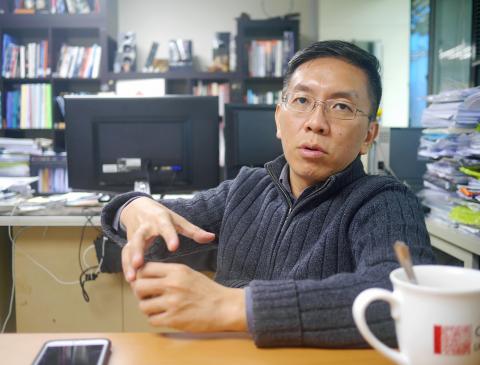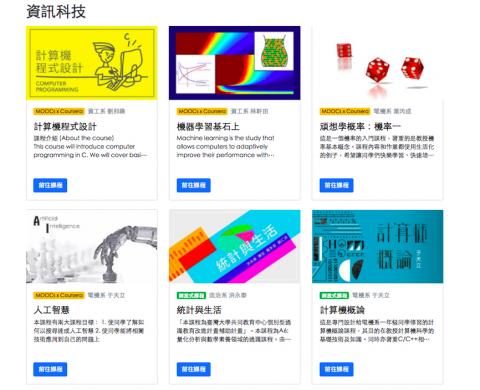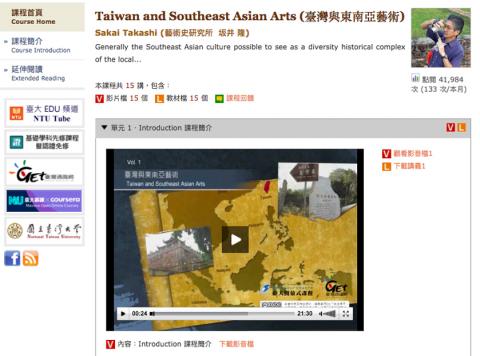Last month, National Taiwan University (NTU) opened an online course portal specifically targeting Southeast Asia offering dozens of courses, hundreds of video tutorials and thousands of lectures on topics ranging from machine learning to marketing, all free of charge.
However, Ngoi Qi Ying, an overseas Chinese student from Malaysia says that without local language subtitles (the courses are currently all in Chinese), the portal will be of limited value to those wanting to access quality Taiwanese education.
Created by NTU’s Center for Learning Development in partnership with the Taipei Economic and Cultural Office in Thailand, team leader Chien Shiuh-shen (簡旭伸) hails the project as a critical step for NTU in becoming a knowledge platform in Southeast Asia.

Photo: Liam Gibson
The portal is structured into four curriculum streams: information technology, business management, humanities in history and Asia Pacific studies. Students can enroll in Massive Online Open Courses, or MOOCs, which are a type of e-learning course made available on the Internet to large numbers of people without charge, or simply access the video tutorials and lectures.
Chien says it is the center’s core mission to make higher education resources public, for use by citizens of the global community regardless of where they live or what time they can study.
“As we are a very good university in the region, it is incumbent upon us to share this expert knowledge,” he says.

Photo: Liam Gibson
Ngoi, who has been studying life science at NTU for three years, says she thinks the project is a positive development. But what Malaysians really need is content in their national language.
“Malaysia is a multicultural country,” she says. “Malay, the national language, is the primary language spoken among Malays, Chinese and Indians alike.”
“If the courses are taught in Chinese, the other ethnic groups won’t be able to understand and won’t benefit,” she says.

Photo: Liam Gibson
Ngoi says adding subtitles to the videos in local languages would help overcome the issue.
Chien says the center is currently expanding its range of English-language courses, as English is the most commonly spoken language throughout the region. He adds that after sufficient English-language content is added, the center will start on Southeast Asian local languages.
However, there is a broader challenge facing the portal — which is spreading the word. Yong Yu Wei, a Malaysian-Chinese student studying at National Taiwan Normal University, says that while the portal sounds like a great resource, most people probably won’t know about it.
Indeed, none of the four Southeast Asian students interviewed for this report had heard of the portal.
Based on the Web site data, the portal has had nearly 1,000 visitors since launching last month on Nov. 24, around 300 from outside of Taiwan and 100 from Thailand alone.
Chien says that while these figures are encouraging, more work needs to be done to raise awareness about the resource and that the center is currently contacting both NTU student groups and organizations across the region to do this.

In Taiwan there are two economies: the shiny high tech export economy epitomized by Taiwan Semiconductor Manufacturing Co (TSMC, 台積電) and its outsized effect on global supply chains, and the domestic economy, driven by construction and powered by flows of gravel, sand and government contracts. The latter supports the former: we can have an economy without TSMC, but we can’t have one without construction. The labor shortage has heavily impacted public construction in Taiwan. For example, the first phase of the MRT Wanda Line in Taipei, originally slated for next year, has been pushed back to 2027. The government

July 22 to July 28 The Love River’s (愛河) four-decade run as the host of Kaohsiung’s annual dragon boat races came to an abrupt end in 1971 — the once pristine waterway had become too polluted. The 1970 event was infamous for the putrid stench permeating the air, exacerbated by contestants splashing water and sludge onto the shore and even the onlookers. The relocation of the festivities officially marked the “death” of the river, whose condition had rapidly deteriorated during the previous decade. The myriad factories upstream were only partly to blame; as Kaohsiung’s population boomed in the 1960s, all household

Allegations of corruption against three heavyweight politicians from the three major parties are big in the news now. On Wednesday, prosecutors indicted Hsinchu County Commissioner Yang Wen-ke (楊文科) of the Chinese Nationalist Party (KMT), a judgment is expected this week in the case involving Hsinchu Mayor Ann Kao (高虹安) of the Taiwan People’s Party (TPP) and former deputy premier and Taoyuan Mayor Cheng Wen-tsan (鄭文燦) of the Democratic Progressive Party (DPP) is being held incommunicado in prison. Unlike the other two cases, Cheng’s case has generated considerable speculation, rumors, suspicions and conspiracy theories from both the pan-blue and pan-green camps.

Stepping inside Waley Art (水谷藝術) in Taipei’s historic Wanhua District (萬華區) one leaves the motorcycle growl and air-conditioner purr of the street and enters a very different sonic realm. Speakers hiss, machines whir and objects chime from all five floors of the shophouse-turned- contemporary art gallery (including the basement). “It’s a bit of a metaphor, the stacking of gallery floors is like the layering of sounds,” observes Australian conceptual artist Samuel Beilby, whose audio installation HZ & Machinic Paragenesis occupies the ground floor of the gallery space. He’s not wrong. Put ‘em in a Box (我們把它都裝在一個盒子裡), which runs until Aug. 18, invites